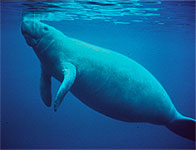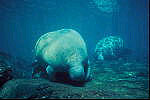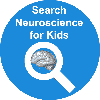 | Red Tide Kills Dolphins and Manatees
Brevetoxin found in marine mammals and in the food they eat |
 |
 | Red Tide Kills Dolphins and Manatees
Brevetoxin found in marine mammals and in the food they eat |
 |
 June 12, 2005
June 12, 2005
Red tides are produced in the ocean by microscopic algae called Karenia
brevis (K. brevis). When there are high concentrations of this algae,
the water can become poisoned when the algae release a toxin called "brevetoxin." Brevetoxin can be eaten or inhaled. This
toxin affects the nervous system by opening sodium
channels on neurons. This can lead to paralysis and loss of
coordination. Red tides kill many fish and can harm people who eat
contaminated shellfish or inhale air containing the toxin.
Although brevetoxin poisoning has been suspected in the deaths of marine mammals, scientists have not known how these
animals come in contact with the toxin. Therefore, researchers studied
27 manatees and 36 bottlenose dolphins that died in Florida in the spring
of 2002 (manatees) and 2004 (dolphins).
High concentrations of brevetoxin were found in tissues (e.g., liver, kidney, lung) and fluids (e.g., blood, stomach contents, urine) of all animals. Because brevetoxin was found in the stomachs of these animals, the researchers concluded that the manatees and dolphins must have eaten contaminated food. Seagrass, a primary part of the manatee diet, contained brevetoxin in the areas where the manatees died. Menhaden, a fish that feeds on plankton, was found in the stomachs of half of the dolphins that died. These fish had high levels of brevetoxins. This is the first evidence that fish are the source of brevetoxin poisoning. Although most people get sick from brevetoxin when they eat contaminated shellfish, these findings suggest that people are also at risk if they eat contaminated fish. |
|
Did you know?
|
|
 References and more information:
References and more information:
|
| GO TO: | Neuroscience In The News | Explore the Nervous System | Table of Contents |
![[email]](./gif/menue.gif) Send E-mail |
 Fill out survey |
 Get Newsletter |
 Search Pages |